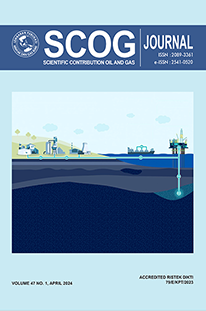The Study of The Sealing Performance of Fibrous-Laden Drilling Fluid Over Simulated Lost Zone Under Overbalanced Pressure Conditions
DOI:
https://doi.org/10.29017/SCOG.47.1.1592Keywords:
drilling fluid, lost circulation, filtration, fibres, muds cakeAbstract
Numerous studies have examined the sealing capabilities of fibrous-amended drilling fluid by measuring filtrate volumes and assessing how well the fibrous plant fragments close fissures. Limited studies have been conducted on the mechanical strength of these materials during the sealing process and their response to plastering pressure. Therefore, this study addressed this gap by providing new data on the relationship between the mechanical strength of fibres and the operating pressure of drilling muds, specifically in preventing lost circulation. The study was carried out using a new experimental methodology involving a high-precision universal tensile machine, which accurately measured the performance of plant fragments in the sealing varying diameters of simulated fractures. Furthermore, the simulated fractures with sizes commonly observed in the field were created to mimic real lost circulation scenarios. The sealing pressure of each fibrous-laden drilling fluid were also observed. The results showed that drilling muds without fibrous additives failed to prevent continued circulation loss, as it lacks the structural integrity necessary for forming a solid muds cake and inhibits infiltration. In contrast, adding plant fragments to drilling muds enables the formation of robust muds cake structures, effectively mitigating drilling fluid losses.References
R. Caenn, H. C. H. Darley, and G. R. Gray, “The Surface Chemistry of Drilling Fluids,†Compos. Prop. Drill. Complet. Fluids, pp. 307– 329, 2011, doi: 10.1016/b978-0-12-383858-2.00007-x.
Forrest, “WO1993001251A1-forrest.pdf,†WO 93/01251, 1993.
R. J. White, “Lost-circulation materials and their evaluation,†Drill. Prod. Pract. 1956, vol. 1956-Janua, pp. 352–359, 1956.
M. E. Hossain and M. Wajheeuddin, “The use of grass as an environmentally friendly additive in water-based drilling fluids,†Pet. Sci., vol. 13, no. 2, pp. 292–303, 2016, doi: 10.1007/s12182- 016-0083-8.
M. Taufik, R. A. Panjaitan, and A. Djambek, “Fibrous organic cellulose application to combat seepage losses in fractured limestone formations, offshore East Kalimantan, Indonesia,†Soc. Pet. Eng. - SPE Asia Pacific Oil Gas Conf. Exhib. 2011, vol. 1, pp. 752–757, 2011, doi: 10.2118/145763-ms.
A. N. Okon, F. D. Udoh, and P. G. Bassey, “Evaluation of rice husk as fluid loss control additive in water-based drilling mud,†38th Niger. Annu. Int. Conf. Exhib. NAICE 2014 - Africa’s Energy Corridor Oppor. Oil Gas Value Maximization Through Integr. Glob. Approach, vol. 1, pp. 391–400, 2014, doi: 10.2118/172379- ms.
A. M. Alsabagh, M. I. Abdou, H. E. S. Ahmed, A. A. S. Khalil, and
A. A. Aboulrous, “Evaluation of some natural water-insoluble cellulosic material as lost circulation control additives in water- based drilling fluid,†Egypt. J. Pet., vol. 24, no. 4, pp. 461–468, 2015, doi: 10.1016/j.ejpe.2015.06.004.
Downloads
Published
Issue
Section
License
Copyright (c) 2024 SCIENTIFIC CONTRIBUTIONS OIL AND GAS (SCOG)

This work is licensed under a Creative Commons Attribution 4.0 International License.
Authors are free to Share — copy and redistribute the material in any medium or format for any purpose, even commercially Adapt — remix, transform, and build upon the material for any purpose, even commercially.
The licensor cannot revoke these freedoms as long as you follow the license terms, under the following terms Attribution — You must give appropriate credit , provide a link to the license, and indicate if changes were made . You may do so in any reasonable manner, but not in any way that suggests the licensor endorses you or your use.
No additional restrictions — You may not apply legal terms or technological measures that legally restrict others from doing anything the license permits.














